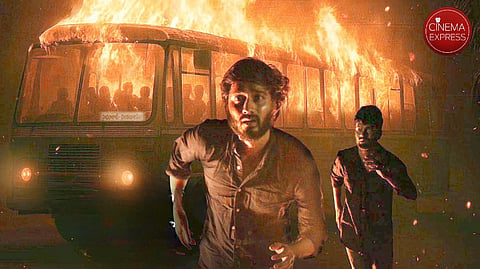23 (Iravai Moodu) Movie Review: An ambitious tearjerker exploring the human condition
23 (Iravai Moodu)(3.5 / 5)
We are so accustomed to ironic use of retro film songs now, a playful spin on our music memories to device a cool visual in action movies, so much so that when Raj R uses a sombre composition like ‘O Maharshi’ at a crucial juncture in 23 (Iravai Moodu), it almost jolts you with its sincerity. The SP Balasubramanaym song was composed for Kamal Haasan starrer Aakali Rajyam, another film about a bunch of underdogs defeated at the hands of system. By using that song here, Raj R doesn’t intend to give it a spin — he merely changes the backdrop, while retaining the soul of it, for newer audience that isn’t used to grittier stories like these anymore. 23 (Iravai Moodu) is a bold independent film that accomplishes plenty with its sincerity and emotional intelligence.
Cast: Teja R, Tanmai Kushi, Jhansi, Pawon Ramesh, Thagabothu Ramesh
Director: Raj R
Written by Raj R in association with Shruti Bhatnagar and Sakshi Gulati, 23 (Iravai Moodu) tells the story of Sagar (Teja R) and Susheela (Tanmai Kushi), a young Dalit couple stirivng to build a life together, with plans of setting up a small Idli center. After his many attempts to acquire a loan go awry, Sagar, in accomplice with his friend Das (Pawon Ramesh), feels compelled to rob a bus full of passengers, but ends up committing a far bigger crime that lands him in prison and up for a possible death sentence. How Sagar deals with his life in prison forms the crux of the story.
The first half of 23 is pacey. While the plot moves briskly, the writer-director also keeps us hooked to the story in other ways. The narrative never lets us forget Sagar’s social status even before he is arrested. There are multiple moments where we can see Sagar and Das getting swatted away from places, be it a small paan shop or a police station. Their presence remains unwarranted everywhere. Be it the way Das is handed over money by a cop, or how Chandra’s bar membership privileges are instantly revoked at the court cafeteria, these visuals of discrimination make a strong imprint. In a chilling visual, a few upper-caste men casually stroll into a Dalit’s courtyard, before setting the house on fire. It’s not the violent act that stuns you, but how casually they walk away afterwards — there are no fervent warcry chants, no aggression. For them, killing someone comes as easily as walking.
Raj R also spends sufficient screentime capturing Sagar and Susheela’s lives at their dayjobs. There is a quiet dignity to these visuals. Someone seeking a crisper narrative would have done away with these scenes, but the Mallesham filmmaker recognises the value here, in the visuals of these factories and mills, with hundreds of people toiling away, underlining the significance of the blue-collar class which remain essential to the functioning of the society, irrespective of their social standing.
When we think of ambitious film making, we think of films with a mammoth production scale, countless junior artists, projects that require a lot of talent management. 23’s ambitions, while of a different kind, are equally daunting. The second half of the film, set almost entirely within a prison, touches upon plenty of issues that are both noble and poignant at once. There is only one larger conflict at play here — whether Sagar and Das will be sentenced to death. However, the plot doesn’t move in a single direction. Instead, we are made privy to slivers of the humane condition in its myriad ways. Under a larger umbrella of exploring characters, Raj R makes space for many interesting segments — a police officer who is equally burdened by guilt as he is with goodness, in his endeavours to reform criminals. There is a convict who remains haunted by the grave repercussions of his crimes. Another inmate confesses to substance abuse, for it’s the only thing that helps him deal with his trauma. During a casual interaction, a jovial prisoner (Thagabothu Ramesh) admits to feelings of irredeemable self-hatred for several years. When a tough prisoner admits to feeling emotional as he looks at his inmate walking to the gallows, his friend admits he just can’t bring himself to cry — that’s how much his life has hardened him emotionally. 23 is obviously preachy in its narrative, almost assuming a documentary-like form in some of its scenes — but it’s also emotionally overwhelming to see such complex and empathetic exploration of humanity.
This ambition often comes at the cost of dramatic strength, though. 23 wants to explore so much that it forgets to touch upon some other crucial, emotional aspects of its universe. For instance, even though Susheela’s ostracisation is consistently referred to in the narrative, we remain emotionally distant to her stigmatised life. Tanmai Kushi, playing Susheela, makes a stellar debut, and is particularly impressive in the emotional segments. Teja R puts in a commendable performance too, but a role like Sagar required a more seasoned actor.
Also, the film often seems interested in trading aesthetics for intent, opting for a filmmaking style that’s too simplistic. What further dampens the impact occasionally is the use of melodramatic background score to underline every emotional moment. The only technical aspect that truly stands out is how the cinematographer Sunny Kurapati strikes a balance between stylistic and natural lighting throughout.
But despite its share of limitations and prototypes, the second half of 23 keeps surprising you with its writing choices. The backdrop maybe confined to prison cells, but Sagar’s perspective and his emotional state keeps shifting as we see him gather a deeper perspective about his crime. A young woman visits him, mentioning how she was 12 years old at the time of the bus burning incident. Another woman later confides about her fears of being the only woman in a room filled with men. What ties the victim and the perpetrator, however, is the hope that things could change. The victim hopes atleast one of the prisoners reflects on their actions. After a point, Sagar hopes that his personal diaries influence someone about their life choices. And just like his many characters, you can see the filmmaker here hoping for the audience to genuinely reflect on the harsh realities that his film captures here.
While 23 largely focuses on Sagar and Das’ tribulations, the filmmaker deftly incorporates two other criminal cases which, despite their limited screentime, go a long way in laying down the context. What Sagar did was unmistakably a grave misdeed, and despite his lack of criminal intentions, he deserves to serve his time. But like most things in life, the idea of justice too remains relative. In an ideal world, everyone would pay an equal price for their misdeeds. However, it’s hard not to weep for Sagar, especially when we know how the system remains lopsided in its treatment of miscreants and anti-social elements who remain safer because of their caste privileges.
And just like justice, the idea of artistic courage too is relative — the significance of any art work depends on the times it belongs to. A film like 23 probably wouldn’t have stood apart in the 1980s, where socially conscious art movies held their ground. But at a time when a film like Phule struggles with censorship, and filmmakers are increasingly going safe in terms of socio-political commentary, a film like 23 goes a long way. It’s a truly courageous piece of filmmaking, in times riddled with fear and caution.

